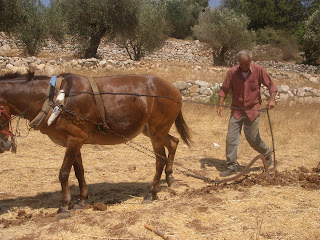

Today we had a Rabbi named Moshe teach our class on reading parables in Rabbinic literature and the Bible. It was really interesting to see how Rabbinic literature compares to Bible parables, and in some instances how it interprets parables in the Bible. He said there are 70 facets/faces to the Torah, meaning there are multiple ways to interpret it. This was a really interesting concept, showing that there are many layers of meaning and approaches to this one text. It made me wonder if the same thing could be said for an evangelical reading of scripture. My professor believes that there is only one way to interpret parables, what do you think? Moshe also said Judaism has the Mishnah to interpret the Torah, and the Talmud to interpret the Mishnah. It reminded me of our many commentaries to help us understand scripture, but these Jewish texts have been elected as THE commentaries. They have more teachings and parables and are referred to as sacred texts. It made me kind of jealous! There are so many times that I am reading the Bible and I feel like I need a teacher to sit down with me and guide my interpretations, or lack there of! There are also many times when I don't know which interpretation is reliable. He pointed out that sometimes parables are used to convey a message that would be difficult for people to hear (using a story would make it less antagonistic and judgmental), communicate difficult concepts using imagery the average person would understand, and to reveal things.
After Moshe spoke in our class, we went to Neot Kedumim, a Biblical landscape reserve in Israel. They have 620 acres between Tel Aviv and Jerusalem where they recreated the landscape you find in the Bible. They have plants and animals from the Bible, ancient and reconstructed olive and wine presses, threshing floors, cisterns, and ritual baths. For our tour we looked at different things that illustrate Biblical parables. We talked about the yearly cycles in Israel during Biblical times, and how they only had two seasons: summer and winter. The Mediterranean climate can be compared to San Diego...where we essentially don't have a Fall or Spring. I didn't realize growing up in San Diego gave me insight into the Bible's climate and landscape! A lot of the landscape in Israel looks familiar, with palm trees here and there. We saw date palms and got to try date palm honey (Luke 13). We also talked about ploughing and sowing, and got to watch a donkey pull a plow that was reconstructed from Biblical times. Then some people in our group got to try it out themselves! This was to go along with the parable: "No man, having put his hand to the plow and looking back, is fit for the kingdom of God" (Luke 9). This makes sense, because you really have to pay attention to where the donkey is going, to make sure it goes in a straight line and doesn't stop and start eating! In the same way, when we say we will follow Jesus we can't look back or we will lose focus and effectiveness in the task at hand. Kind of true with life in general, eh? We also got to scatter barely seeds and illustrate seeds falling by the wayside, on stony ground, among thorns, and on good ground (Mark 4). It was interesting for me to see the actual terrain this parable referenced. We spent some time illustrating the threshing floor and winnowing fork that is referenced in Ruth. The winnowing fork was cool to see because all the chaff blows away when you lift up the wheat and the grain falls back down into the pile. This is what the Psalmist means when he says, "Not so the wicked; they are like the chaff that the wind blows away." Finally, we got to herd sheep and goats! The shepherd has to guide the animals from the back and then be ready to guide them from all sides as they get confused and scared. One of the guys in our group worked on a sheep farm for a summer when he was fourteen, because both of his parents died unexpectedly and they had him go there while figuring out who he would live with. He had funny stories about how dumb sheep are: they'll stand in hail that will beat them to death, and in the heat they will put their faces together and suffocate! Kind of morbid, but it helped illustrate how much we are need of God as our Shepherd to protect us from even our own judgment, and to intercede on our behalf as he has the greater perspective/vision of what is going on in our lives.
And that was the day of parables!
I bet you'll never forget these visual, hands-on lessons. And I bet it will inform and impact your teaching in amazing ways!
ReplyDelete